Experimental and Artificial Neural Network-Based Study on the Sorptivity Characteristics of Geopolymer Concrete with Recycled Cementitious Materials and Basalt Fibres
Abstract
:1. Introduction
2. Materials and Methods
2.1. Recycled Binder Materials
2.2. Chopped Basalt Fibres
2.3. Alkali Activator
2.4. Aggregates
2.5. Mix Design
2.6. Test Methods
2.6.1. Capillary Water Absorption and Sorptivity
- I = the absorption, mm
- mt = the change in specimen mass in grams, at the time t,
- a = the exposed area of the specimen, in mm2, and
- d = the density of the water in g/mm3.
2.6.2. Compressive Strength
2.6.3. Indirect Tensile Strength
3. Results and Discussion
3.1. Workability and Mechanical Properties
3.2. Sorptivity Characteristics of the Geopolymer Concrete Mixes
3.2.1. Sorptivity of the Self-Compacting Geopolymer Concrete (SCGC)
3.2.2. Sorptivity of the Geopolymer Concrete Containing 12 mm Basalt Fibres (SCGC-B-12)
3.2.3. Sorptivity of the Geopolymer Concrete Containing 30 mm Basalt Fibres (SCGC-B-30)
3.3. Comparison of Sorptivity Characteristics
3.4. Artificial Neural Network (ANN) for Prediction of Sorptivity Characteristics
4. Conclusions
- The water absorption rates of the SCGC specimens containing chopped basalt fibres were lower by around 72% for the initial 6 h of exposure, stabilising for the 7 days and long-term exposure until saturation of the test specimens.
- The weight change of specimens was significant for SCGC mix without any fibres reporting an increase of up to 5.5% until the samples were completely saturated. In contrast, the models containing 12 mm and 30 mm chopped basalt fibres reported a rise of only 1.86% and 1.96%, respectively, at saturation compared to the initial weight of dry specimens.
- The addition of 12 mm- and 30 mm-long fibres at 1% by weight of total binders has improved the permeability characteristics of the geopolymer concrete mix. However, it reported a slight decrease in the mechanical and flowability properties for the compressive strength, tensile strength, and slump flow.
- Adding chopped basalt fibres can offer improved permeability and denser geopolymer concrete. However, there is a need for more research on the optimisation of the chopped basalt fibre length and the need for investigating other weight ratios of fibre quantities.
- The ANN prediction model confirmed an excellent alignment between the experimental observations and model predictions, offering a new sorptivity prediction model for geopolymer concrete mixes.
Author Contributions
Funding
Data Availability Statement
Acknowledgments
Conflicts of Interest
References
- Wei, X.; Ming, F.; Li, D.; Chen, L.; Liu, Y. Influence of water content on mechanical strength and microstructure of alkali-activated Fly Ash/GGBFS mortars cured at cold and polar regions. Materials 2020, 13, 138. [Google Scholar] [CrossRef] [Green Version]
- Mohajerani, A.; Suter, D.; Jeffrey-Bailey, T.; Song, T.; Arulrajah, A.; Horpibulsuk, S.; Law, D. Recycling waste materials in geopolymer concrete. Clean Technol. Environ. Policy 2019, 21, 493–515. [Google Scholar] [CrossRef]
- Van Deventer, J.S.J.J.; Provis, J.L.; Duxson, P. Technical and commercial progress in the adoption of geopolymer cement. Miner. Eng. 2012, 29, 89–104. [Google Scholar] [CrossRef]
- Rahman, S.K.; Al-Ameri, R. A newly developed self-compacting geopolymer concrete under ambient condition. Constr. Build. Mater. 2021, 267, 121822. [Google Scholar] [CrossRef]
- Rahman, S.K.; Al-Ameri, R. Marine Geopolymer Concrete—A Hybrid Curable Self-Compacting Sustainable Concrete for Marine Applications. Appl. Sci. 2022, 12, 3116. [Google Scholar] [CrossRef]
- Imtiaz, L.; Rehman, S.K.U.; Ali Memon, S.; Khizar Khan, M.; Faisal Javed, M. A Review of Recent Developments and Advances in Eco-Friendly Geopolymer Concrete. Appl. Sci. 2020, 10, 7838. [Google Scholar] [CrossRef]
- Rahma, S.K.; Al-Ameri, R. The Need for a User Friendly Geopolymer Concrete-Ongoing Research. Proc. Concr. 2021. Available online: http://www.ciaconference.com.au/concrete2021/pdf/full-paper_43.pdf (accessed on 13 July 2022).
- Rahmawati, C.; Aprilia, S.; Saidi, T.; Aulia, T.B. Current development of geopolymer cement with nanosilica and cellulose nanocrystals. J. Phys. Conf. Ser. 2021, 1783, 012056. [Google Scholar] [CrossRef]
- Omer, L.M.; Gomaa, M.S.; Sufe, W.H.; Elsayed, A.A.; Elghazaly, H.A. Enhancing corrosion resistance of RC pipes using geopolymer mixes when subjected to aggressive environment. J. Eng. Appl. Sci. 2022, 69, 1. [Google Scholar] [CrossRef]
- Goswami, A.P. Determining physico-chemical parameters for high strength ambient cured fly ash-based alkali-activated cements. Ceram. Int. 2021, 47, 29109–29119. [Google Scholar] [CrossRef]
- Mehta, A.; Siddique, R. An overview of geopolymers derived from industrial by-products. Constr. Build. Mater. 2016, 127, 183–198. [Google Scholar] [CrossRef]
- Dhasindrakrishna, K.; Pasupathy, K.; Ramakrishnan, S.; Sanjayan, J. Progress, current thinking and challenges in geopolymer foam concrete technology. Cem. Concr. Compos. 2021, 116, 103886. [Google Scholar] [CrossRef]
- Flower, D.J.M.; Sanjayan, J.G. Greenhouse Gas Emissions Due to Concrete Manufacture; Elsevier Inc.: Amsterdam, The Netherlands, 2017. [Google Scholar] [CrossRef]
- Rizaldi, N.; Abdurrahman, H.; Wijaya, M.F.; Wibisono, G.; Olivia, M. Durability of fly ash geopolymer hybrid concrete in seawater, sulfuric acid, and fire resistant-A review. J. Phys. Conf. Ser. 2021, 2049, 012088. [Google Scholar] [CrossRef]
- Júnior, L.U.D.T.; Taborda-Barraza, M.; Cheriaf, M.; Gleize, P.J.P.; Rocha, J.C. Effect of bottom ash waste on the rheology and durability of alkali activation pastes. Case Stud. Constr. Mater. 2022, 16, e00790. [Google Scholar] [CrossRef]
- Diaz, E.I.; Allouche, E.N.; Eklund, S. Factors affecting the suitability of fly ash as source material for geopolymers. Fuel 2010, 89, 992–996. [Google Scholar] [CrossRef]
- Sandanayake, M.; Gunasekara, C.; Law, D.; Zhang, G.; Setunge, S. Greenhouse gas emissions of different fly ash based geopolymer concretes in building construction. J. Clean. Prod. 2018, 204, 399–408. [Google Scholar] [CrossRef]
- Trabacchin, G.; Ayala, D.D.; Stegemann, J.; Zhang, M. Bond Behaviour of Basalt FRP bars in Geopolymer Concrete. In Proceedings of the 1st International Conference in Low-Carbon Cement & Concrete Technology, London, UK, 23–26 June 2019; pp. 1–4. [Google Scholar]
- Al-Majidi, M.H.; Lampropoulos, A.; Cundy, A.; Meikle, S. Development of geopolymer mortar under ambient temperature for in situ applications. Constr. Build. Mater. 2016, 120, 198–211. [Google Scholar] [CrossRef] [Green Version]
- Li, W.; Shumuye, E.D.; Shiying, T.; Wang, Z.; Zerfu, K. Eco-friendly fibre reinforced geopolymer concrete: A critical review on the microstructure and long-term durability properties. Case Stud. Constr. Mater. 2022, 16, e00894. [Google Scholar] [CrossRef]
- Dombrowski, K.; Weil, M.; Buchwald, A. Geopolymer Binders Part 2: Development and Optimization of Geopolymer Concrete Mixtures for Strong and Durable External Wall Units. ZKG Int. 2008, 61, 70–80. Available online: https://www.scopus.com/inward/record.uri?eid=2-s2.0-41149137204&partnerID=40&md5=b8b95fb663010b110e2b49cddd842566 (accessed on 13 July 2022).
- Łach, M.; Kluska, B.; Janus, D.; Kabat, D.; Pławecka, K.; Korniejenko, K.; Guigou, M.D.; Choińska, M. Effect of Fiber Reinforcement on the Compression and Flexural Strength of Fiber-Reinforced Geopolymers. Appl. Sci. 2021, 11, 10443. [Google Scholar] [CrossRef]
- Wu, H.; Qian, X.Q.; Li, C.Z.; Li, F. Ecological Environment and Technology of Concrete; Key Engineering Materials: 2011; Volume 477. Available online: https://www.scopus.com/inward/record.uri?eid=2-s2.0-85086682638&partnerID=40&md5=6e81d7d029b508f3bbffa4e22e5c2d12 (accessed on 13 July 2022).
- Girgin, Z.C.; Yıldırım, M.T. Usability of basalt fibres in fibre reinforced cement composites. Mater. Struct. 2016, 49, 3309–3319. [Google Scholar] [CrossRef]
- Krishna, R.S.; Shaikh, F.; Mishra, J.; Lazorenko, G.; Kasprzhitskii, A. Mine tailings-based geopolymers: Properties, applications and industrial prospects. Ceram. Int. 2021, 47, 17826–17843. [Google Scholar] [CrossRef]
- Fu, Q.; Zhang, Z.; Xu, W.; Zhao, X.; Zhang, L.; Wang, Y.; Niu, D. Flexural Behavior and Prediction Model of Basalt Fiber/Polypropylene Fiber-Reinforced Concrete. Int. J. Concr. Struct. Mater. 2022, 16, 1–16. [Google Scholar] [CrossRef]
- Shaikh, F.; Haque, S. Behaviour of Carbon and Basalt Fibres Reinforced Fly Ash Geopolymer at Elevated Temperatures. Int. J. Concr. Struct. Mater. 2018, 12, 35. [Google Scholar] [CrossRef] [Green Version]
- High, C.; Seliem, H.M.; El-Safty, A.; Rizkalla, S.H. Use of basalt fibers for concrete structures. Constr. Build. Mater. 2015, 96, 37–46. [Google Scholar] [CrossRef]
- John, V.J.; Dharmar, B. Influence of basalt fibers on the mechanical behavior of concrete—A review. Struct. Concr. 2021, 22, 491–502. [Google Scholar] [CrossRef]
- Adesina, A. Performance of cementitious composites reinforced with chopped basalt fibres–An overview. Constr. Build. Mater. 2021, 266, 120970. [Google Scholar] [CrossRef]
- Hu, X.; Guo, Y.; Lv, J.; Mao, J. The Mechanical Properties and Chloride Resistance of Concrete Reinforced with Hybrid Polypropylene and Basalt Fibres. Materials 2019, 12, 2371. [Google Scholar] [CrossRef] [Green Version]
- Korniejenko, K.; Mucsi, G.; Halyag, N.P.; Szabó, R.; Mierzwiński, D.; Louda, P. Mechanical Properties of Basalt Fiber Reinforced Fly Ash-Based Geopolymer Composites. KnE Eng. 2020, 2020, 86–100. [Google Scholar] [CrossRef] [Green Version]
- Le, C.H.; Louda, P.; Buczkowska, K.E.; Dufkova, I. Investigation on Flexural Behavior of Geopolymer-Based Carbon Textile/Basalt Fiber Hybrid Composite. Polymers 2021, 13, 751. [Google Scholar] [CrossRef]
- Pasupathy, K.; Sanjayan, J.; Rajeev, P.; Law, D.W. The effect of chloride ingress in reinforced geopolymer concrete exposed in the marine environment. J. Build. Eng. 2021, 39, 102281. [Google Scholar] [CrossRef]
- Pasupathy, K.; Cheema, D.S.; Sanjayan, J. Durability performance of fly ash-based geopolymer concrete buried in saline environment for 10 years. Constr. Build. Mater. 2021, 281, 122596. [Google Scholar] [CrossRef]
- Tang, Y.X.; Lee, Y.H.; Amran, M.; Fediuk, R.; Vatin, N.; Kueh, A.B.H.; Lee, Y.Y. Artificial Neural Network-Forecasted Compression Strength of Alkaline-Activated Slag Concretes. Sustainability 2022, 14, 5214. [Google Scholar] [CrossRef]
- Mashrei, M.A.; Seracino, R.; Rahman, M.S. Application of artificial neural networks to predict the bond strength of FRP-to-concrete joints. Constr. Build. Mater. 2013, 40, 812–821. [Google Scholar] [CrossRef]
- Rahman, S.K.; Al-Ameri, R. Experimental Investigation and Artificial Neural Network Based Prediction of Bond Strength in Self-Compacting Geopolymer Concrete Reinforced with Basalt FRP Bars. Appl. Sci. 2021, 11, 4889. [Google Scholar] [CrossRef]
- Asteris, P.G.; Kolovos, K.G.; Douvika, M.G.; Roinos, K. Prediction of self-compacting concrete strength using artificial neural networks. Eur. J. Environ. Civ. Eng. 2016, 20, s102–s122. [Google Scholar] [CrossRef]
- Alnedawi, A.; Al-Ameri, R.; Nepal, K.P. Neural network-based model for prediction of permanent deformation of unbound granular materials. J. Rock Mech. Geotech. Eng. 2019, 11, 1231–1242. [Google Scholar] [CrossRef]
- Haddad, R.; Haddad, M. Predicting fiber-reinforced polymer–concrete bond strength using artificial neural networks: A comparative analysis study. Struct. Concr. 2020, 22, 38–49. [Google Scholar] [CrossRef]
- Karimipour, A.; Jahangir, H.; Eidgahee, D.R. A thorough study on the effect of red mud, granite, limestone and marble slurry powder on the strengths of steel fibres-reinforced self-consolidation concrete: Experimental and numerical prediction. J. Build. Eng. 2021, 44, 103398. [Google Scholar] [CrossRef]
- Chong, B.W.; Othman, R.; Jaya, R.P.; Hasan, M.M.; Sandu, A.; Nabiałek, M.; Jeż, B.; Pietrusiewicz, P.; Kwiatkowski, D.; Postawa, P.; et al. Design of Experiment on Concrete Mechanical Properties Prediction: A Critical Review. Materials 2021, 14, 1866. [Google Scholar] [CrossRef]
- Golafshani, E.M.; Rahai, A.; Sebt, M.H. Artificial neural network and genetic programming for predicting the bond strength of GFRP bars in concrete. Mater. Struct. Constr. 2015, 48, 1581–1602. [Google Scholar] [CrossRef]
- Zinkaah, O.H.; Al-Rifaie, A.; Alhawat, M.M. Predictability of existing standard codes for the flexural strength of beams produced from alkali-activated concrete. AIP Conf. Proc. 2021, 2404, 080031. [Google Scholar] [CrossRef]
- Gao, J.; Koopialipoor, M.; Armaghani, D.J.; Ghabussi, A.; Baharom, S.; Morasaei, A.; Shariati, A.; Khorami, M. Evaluating the bond strength of FRP in concrete samples using machine learning methods. Smart Struct. Syst. 2020, 26, 403–418. [Google Scholar] [CrossRef]
- Rahman, S.; John, K.; Kafle, B.; Al-Ameri, R. Structural Performance of Modular Sandwich Composite Floor Slabs Containing Basalt FRP-Reinforced Self-Compacting Geopolymer Concrete. Appl. Sci. 2022, 12, 4246. [Google Scholar] [CrossRef]
- Efnarc, F. Specification and Guidelines for Self-Compacting Concrete; European Federation for Specialist Construction Chemicals and Concrete Systems: Farnham, UK, 2002. [Google Scholar]
- ASTM C1585-13; Standard Test Method for Measurement of Rate of Absorption of Water by Hydraulic Cement Concretes. ASTM International: West Conshohocken, PA, USA, 2013; Volume 41, pp. 1–6. [CrossRef]
- AS 1012.9:2014; Methods of Testing Concrete. Method 9: Compressive Strength Tests: Concrete, Mortar and Grout Specimens. Aust. Stand. Aust. Ltd.: Sydney, Australia, 2014.
- AS 1012.10-2000; Methods of Testing Concrete-Determination of Indirect Tensile Strength of Concrete Cylinders. Standards Australia: Sydney, Australia, 2000.
- Rahimireskati, S.; Ghabraie, K.; Garcez, E.O.; Al-Ameri, R. Improving sorptivity and electrical resistivity of concrete utilising biomedical polymeric waste sourced from dialysis treatment. Int. J. Sustain. Eng. 2021, 14, 820–834. [Google Scholar] [CrossRef]
- Aquino, K.P.S.; Caisip, J.S.; Placiente, A.N.I.; Reyes, E.C.; Calilung, M.G.V. Application of artificial neural network in determination of sorptivity model of concrete with varying percent of replacement of sand to copper slag. In Proceedings of the 2017 IEEE 9th International Conference on Humanoid, Nanotechnology, Information Technology, Communication and Control, Environment and Management (HNICEM), Manila, Philippines, 1–3 December 2017; pp. 1–5. [Google Scholar] [CrossRef]
- Najigivi, A.; Khaloo, A.; Abdul Rashid, S. An artificial neural networks model for predicting permeability properties of nano silica–rice husk ash ternary blended concrete. Int. J. Concr. Struct. Mater. 2013, 7, 225–238. [Google Scholar] [CrossRef] [Green Version]
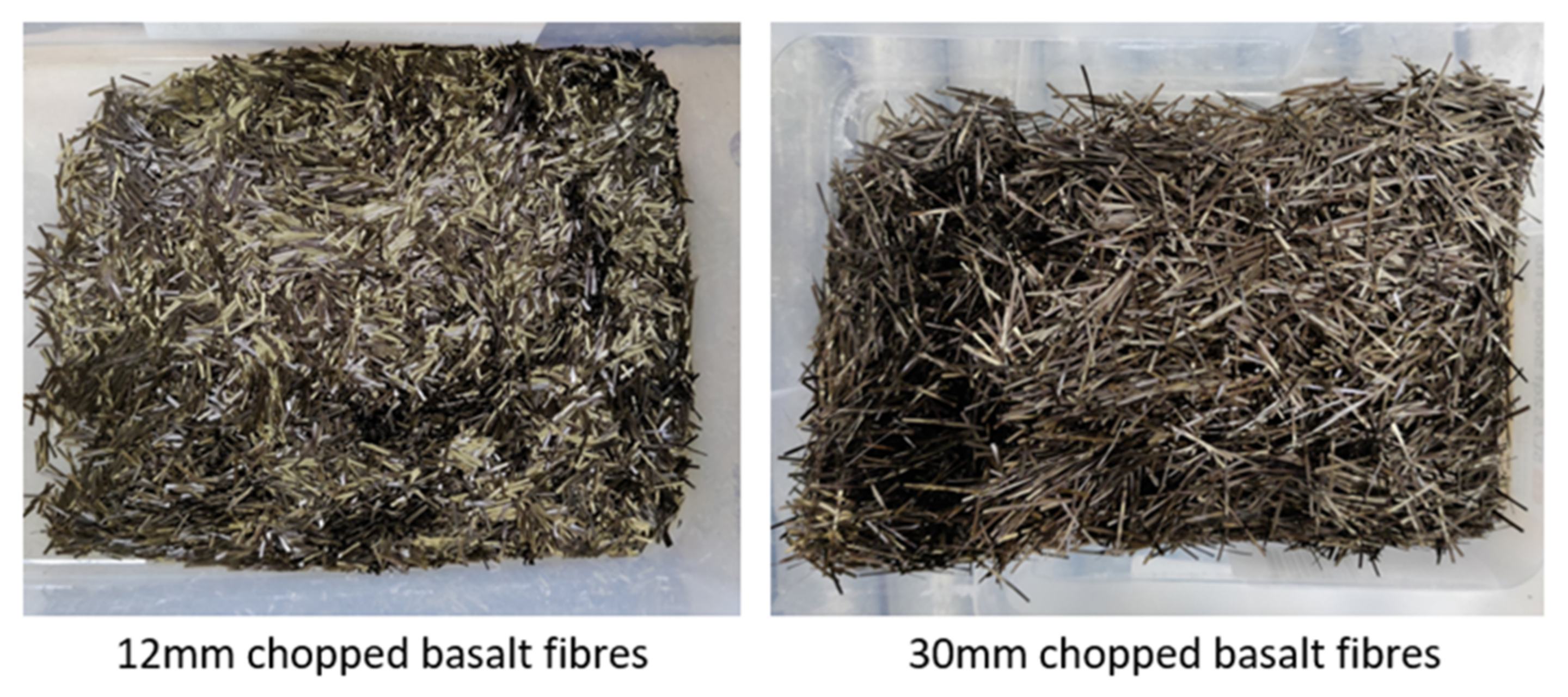
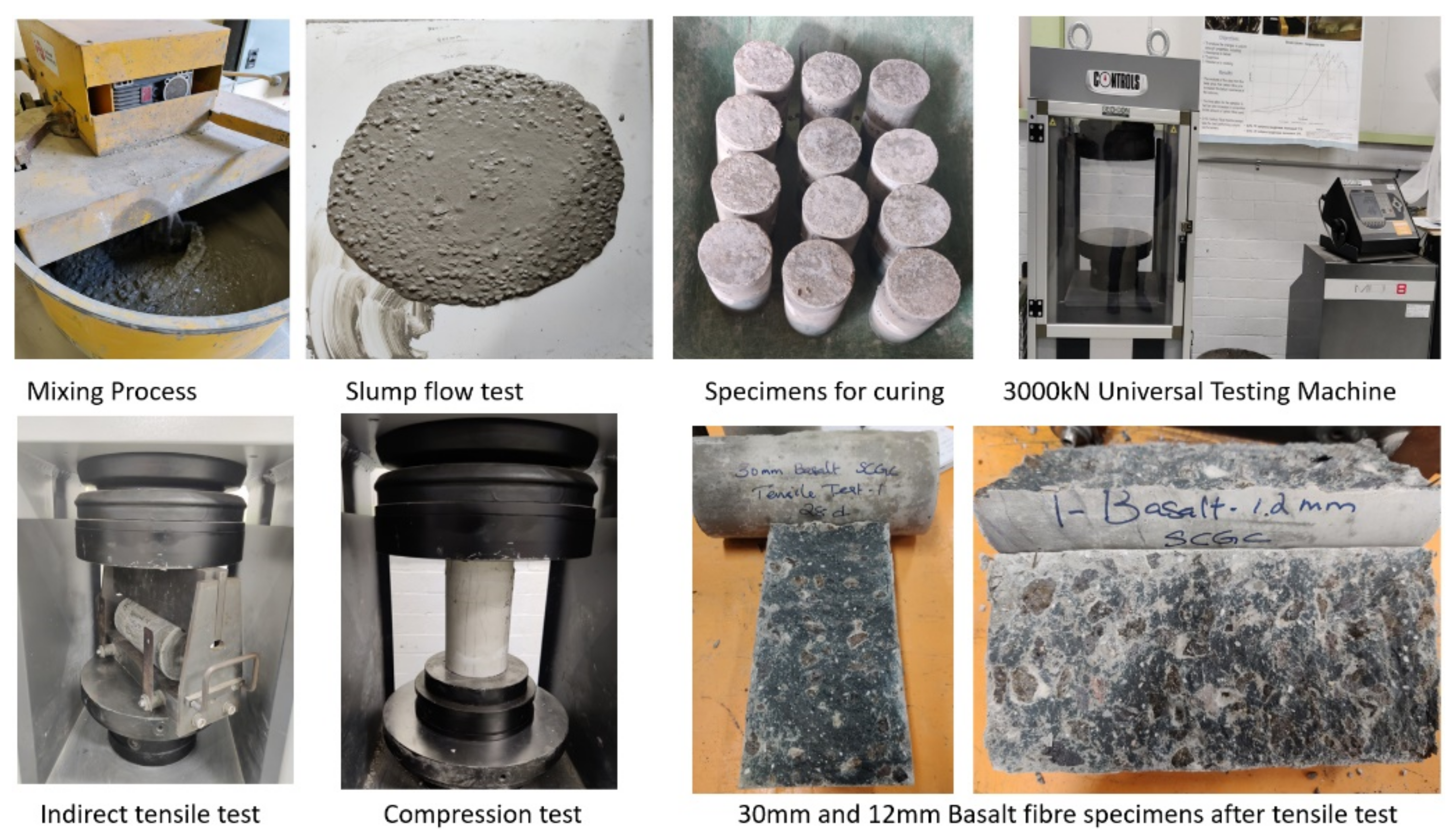
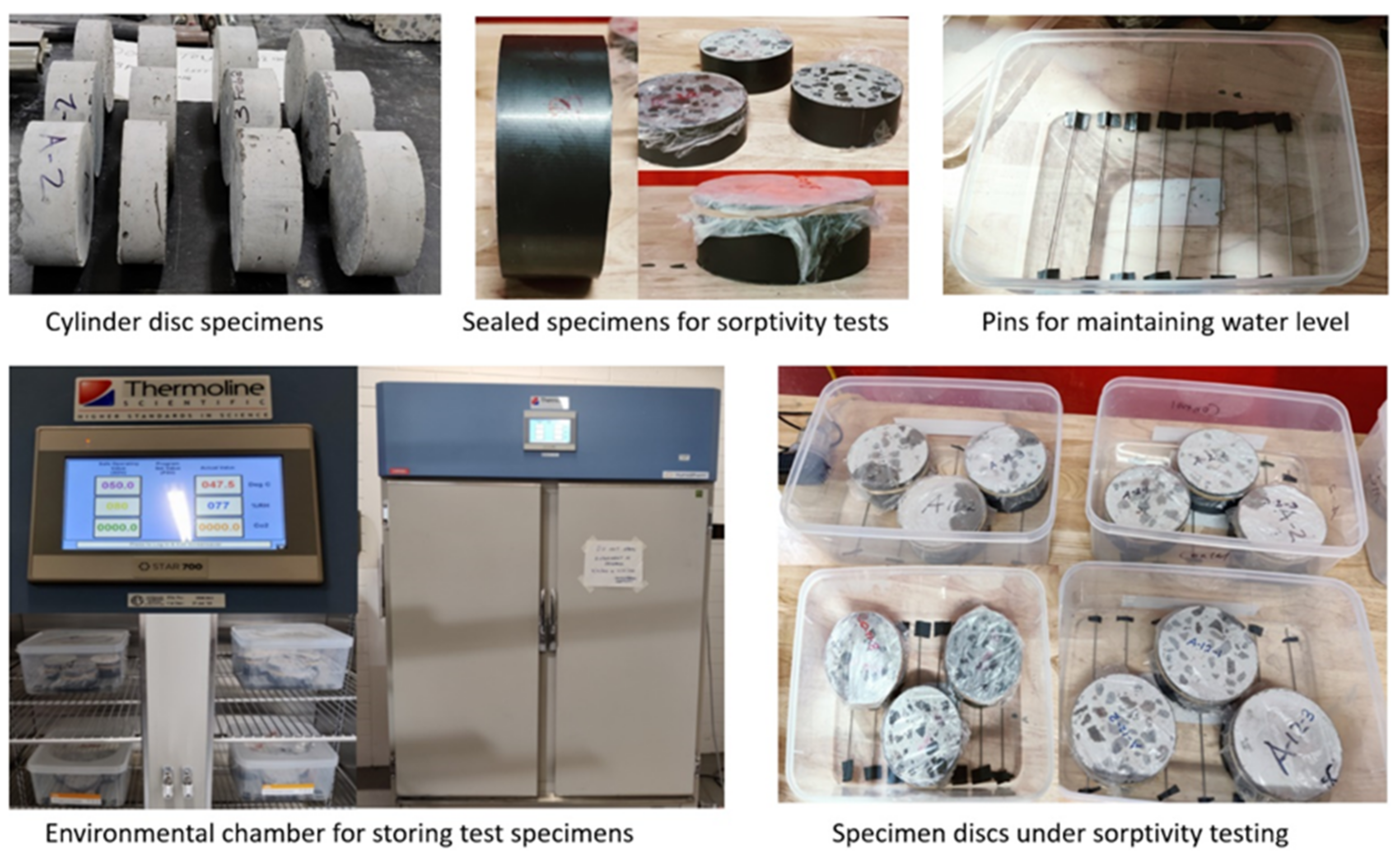
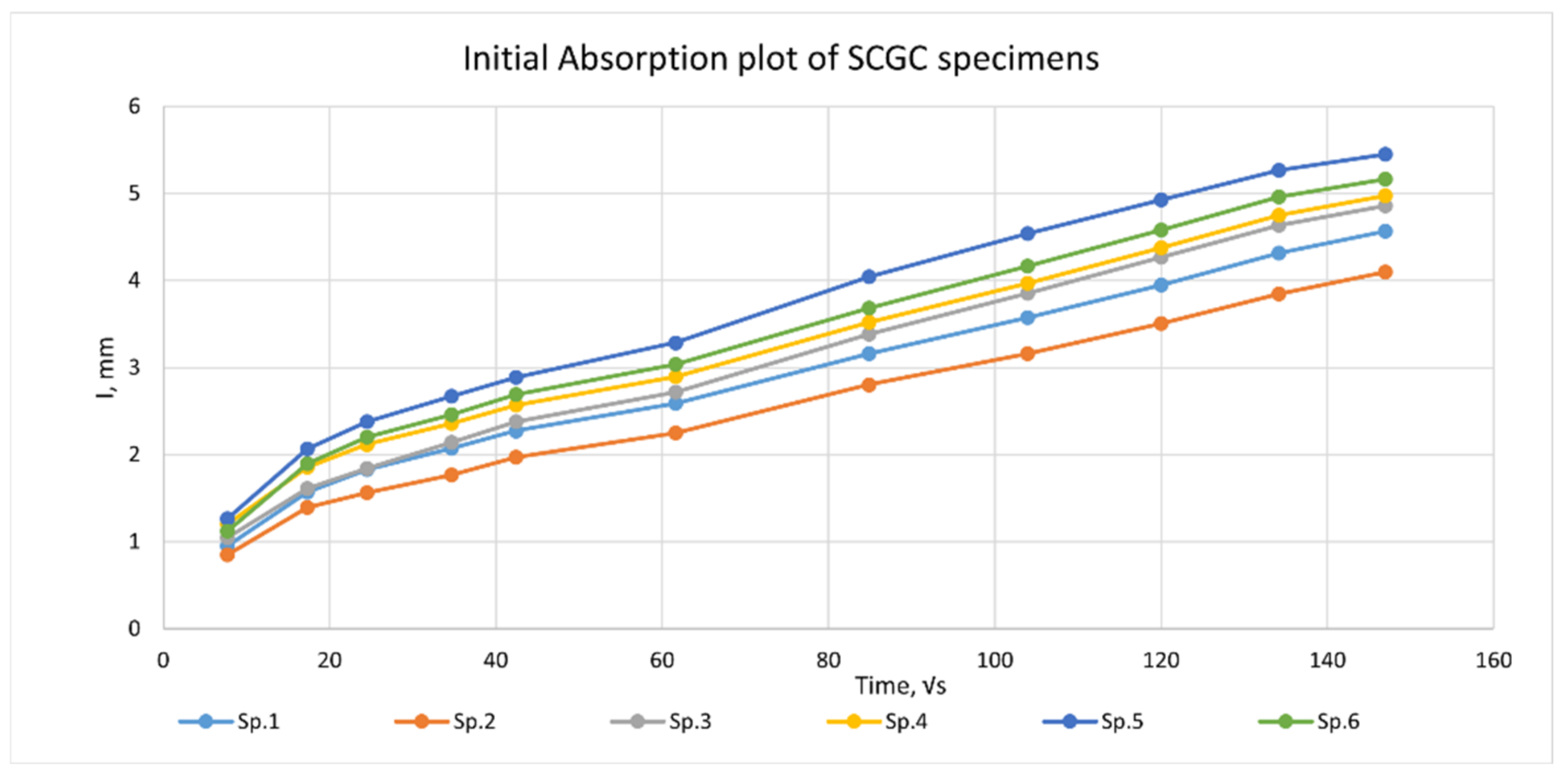

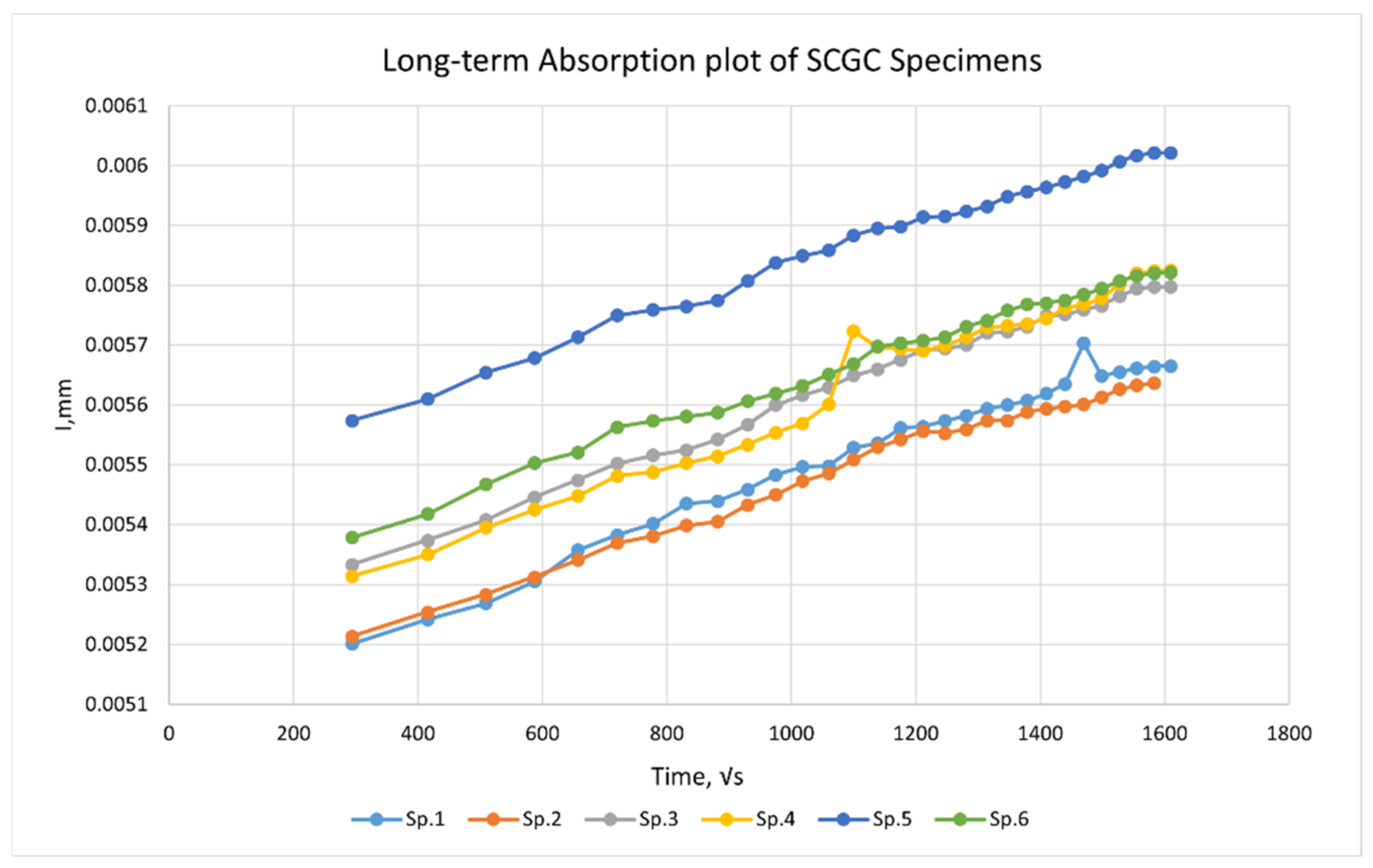

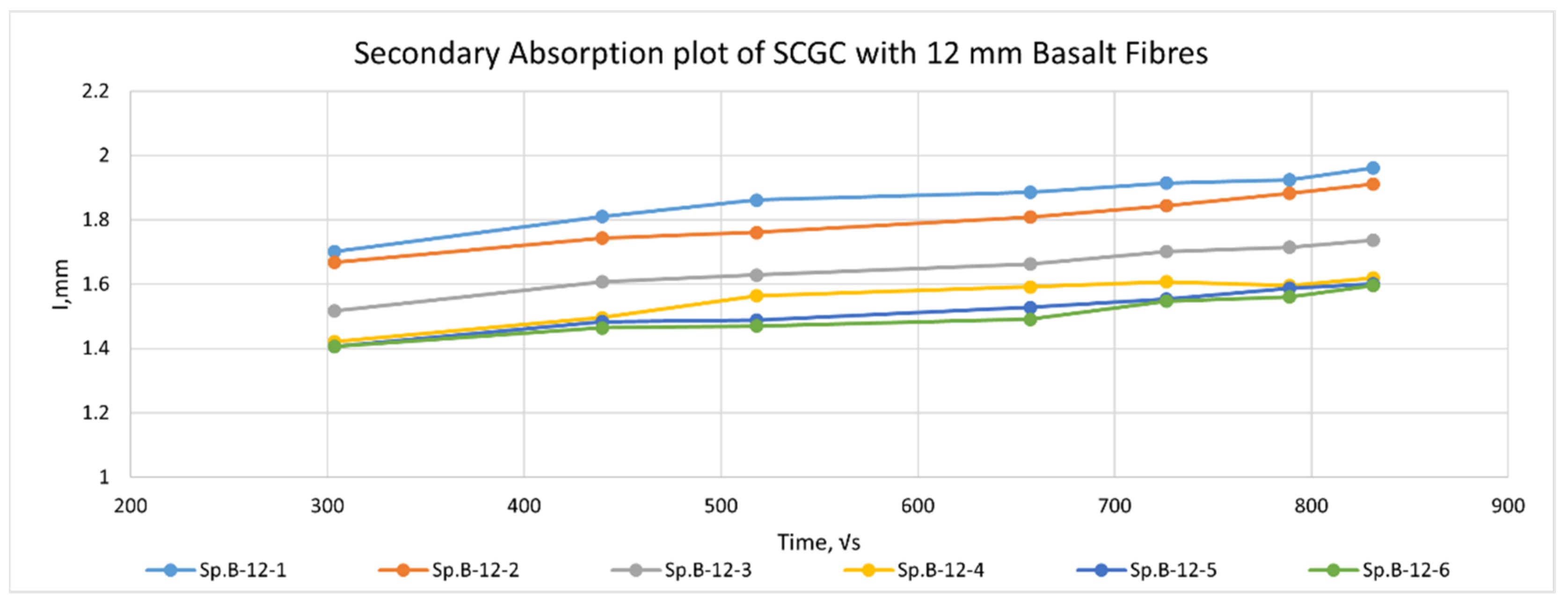

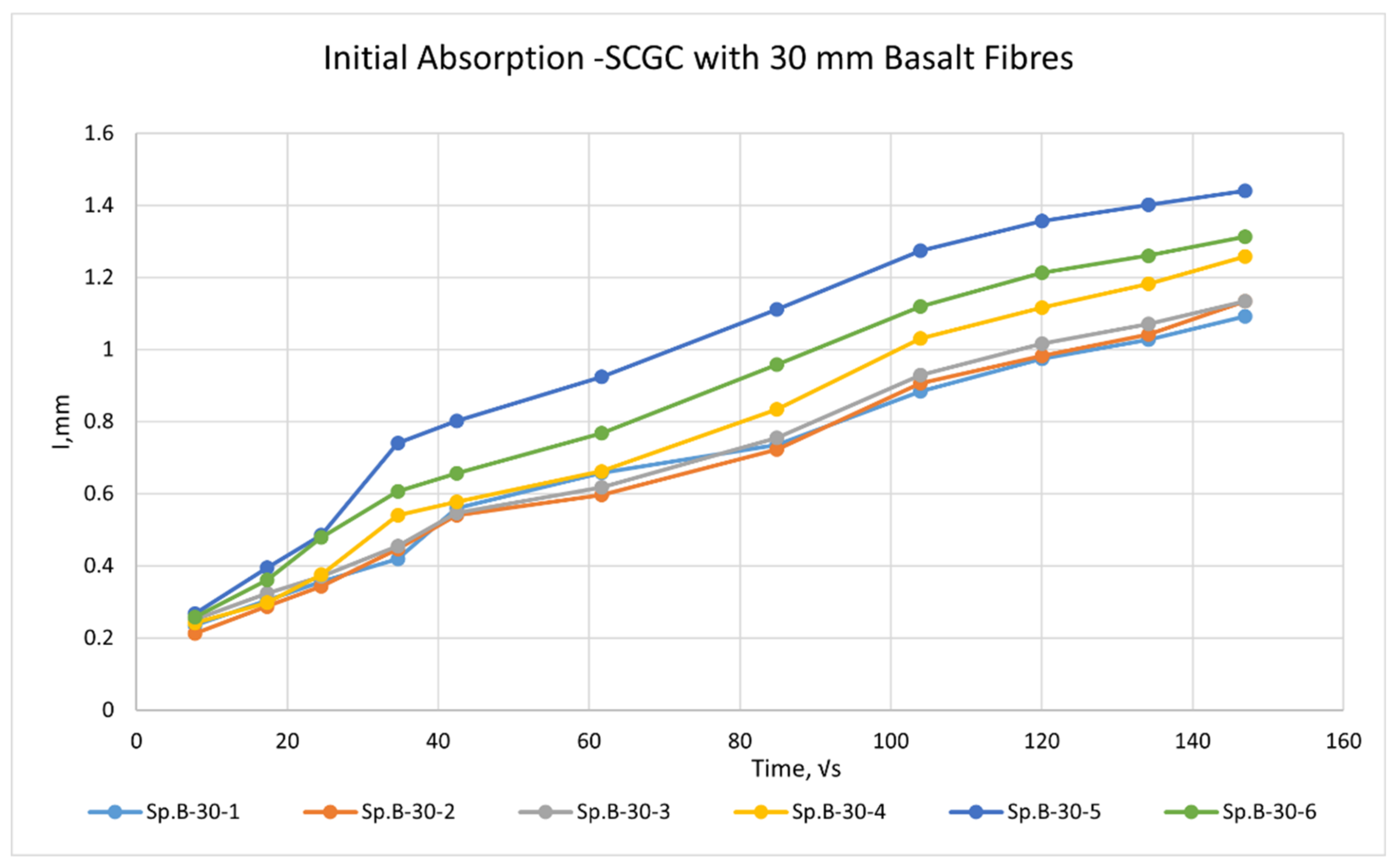
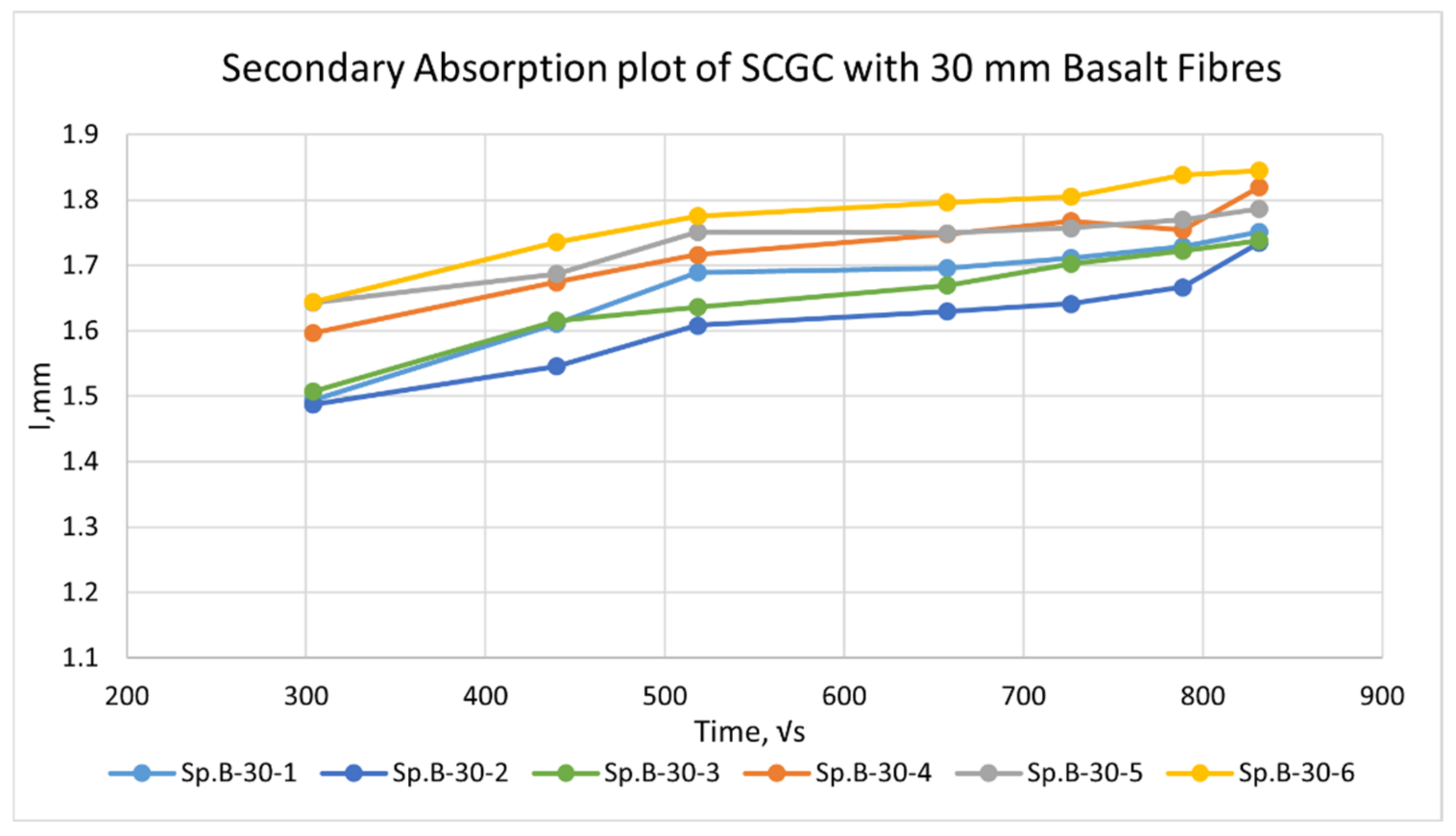
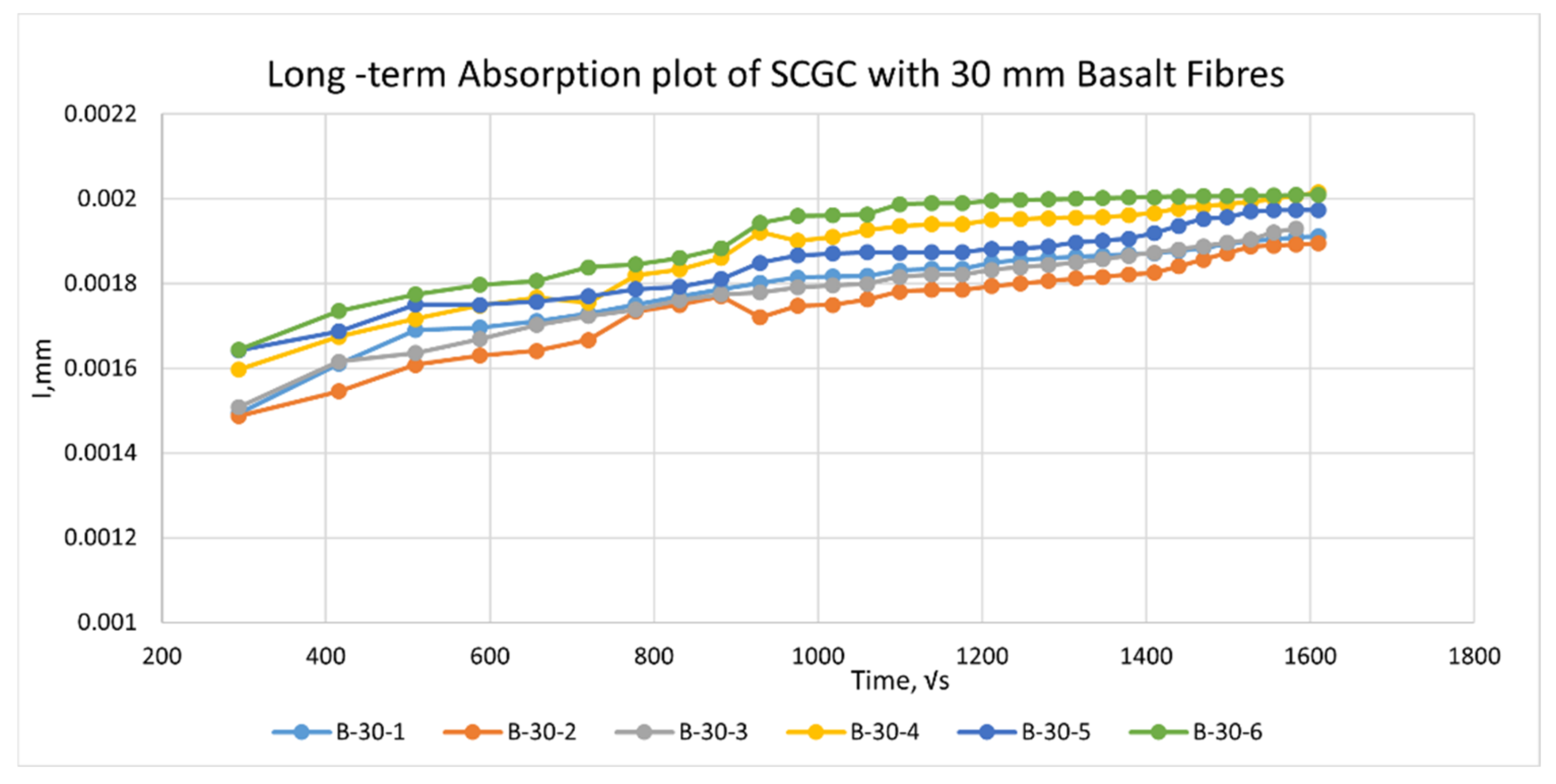
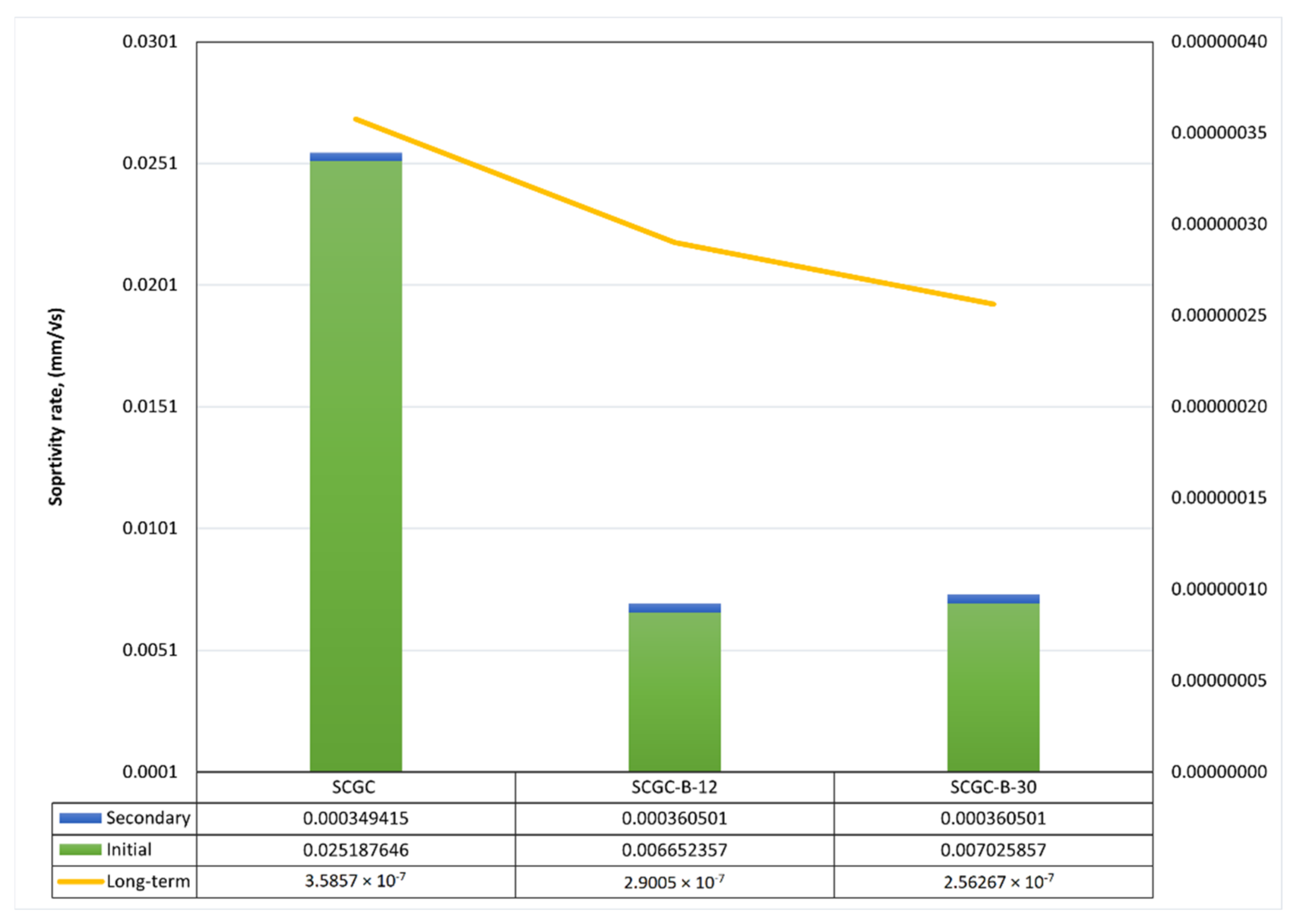
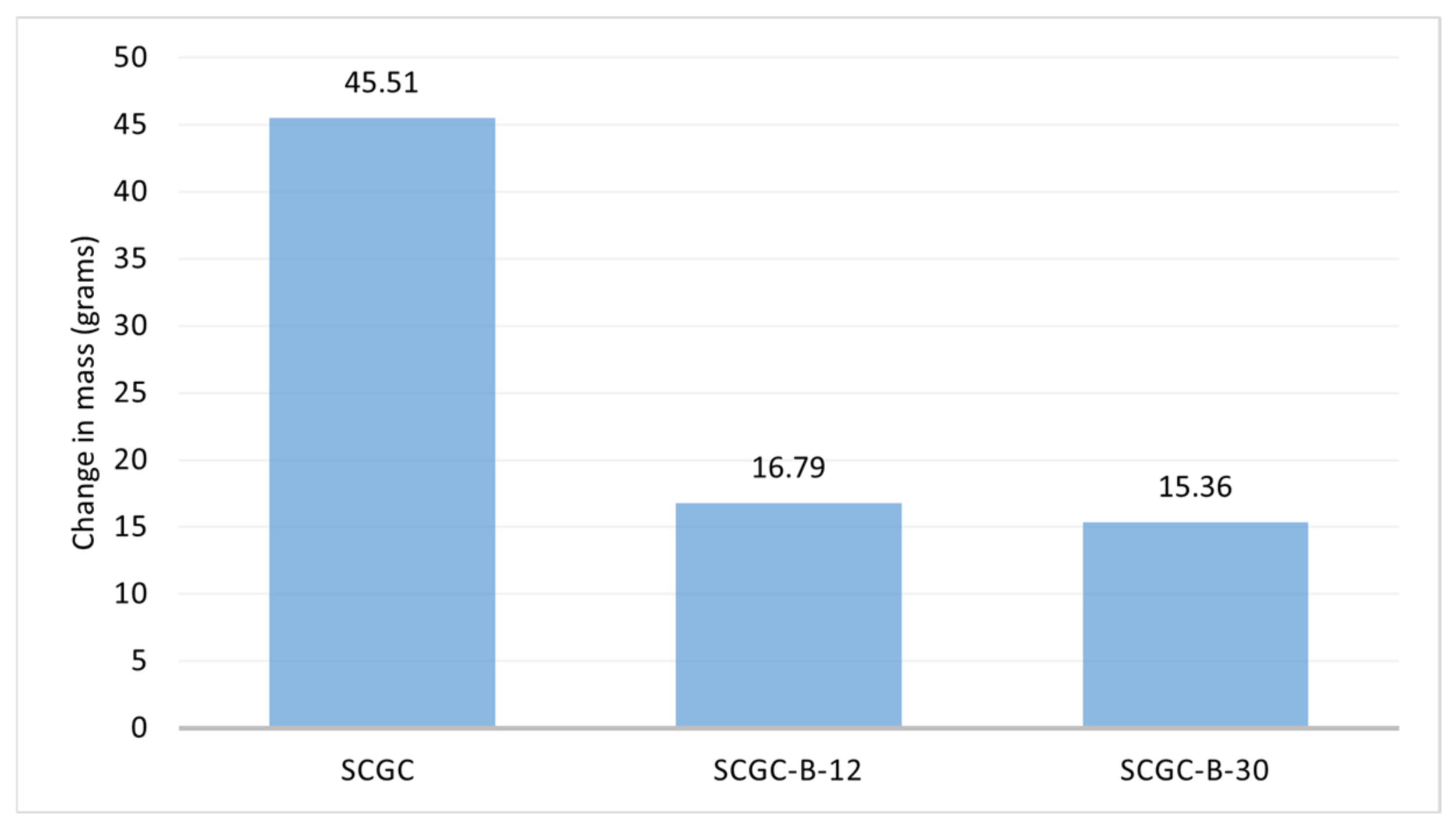

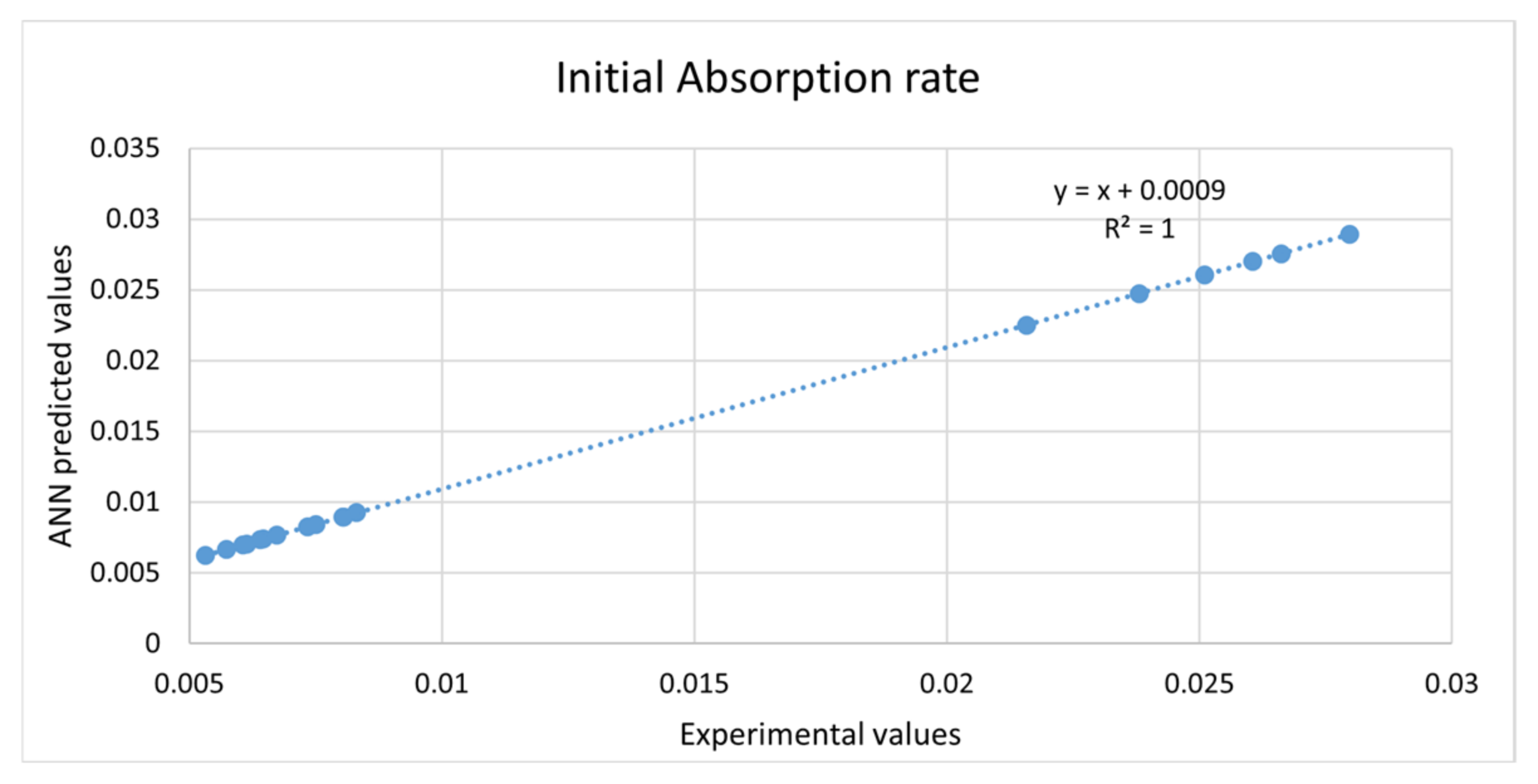
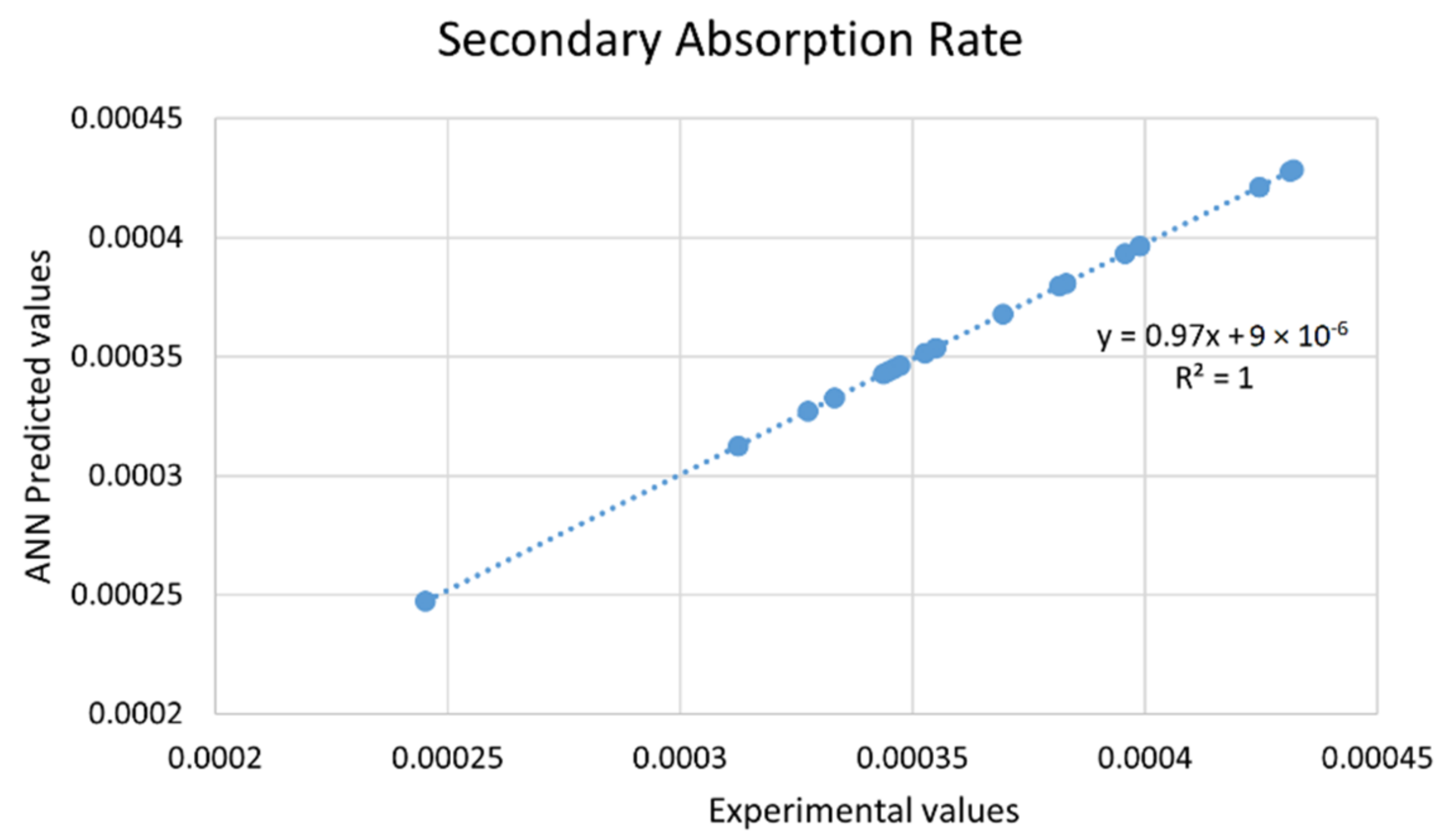

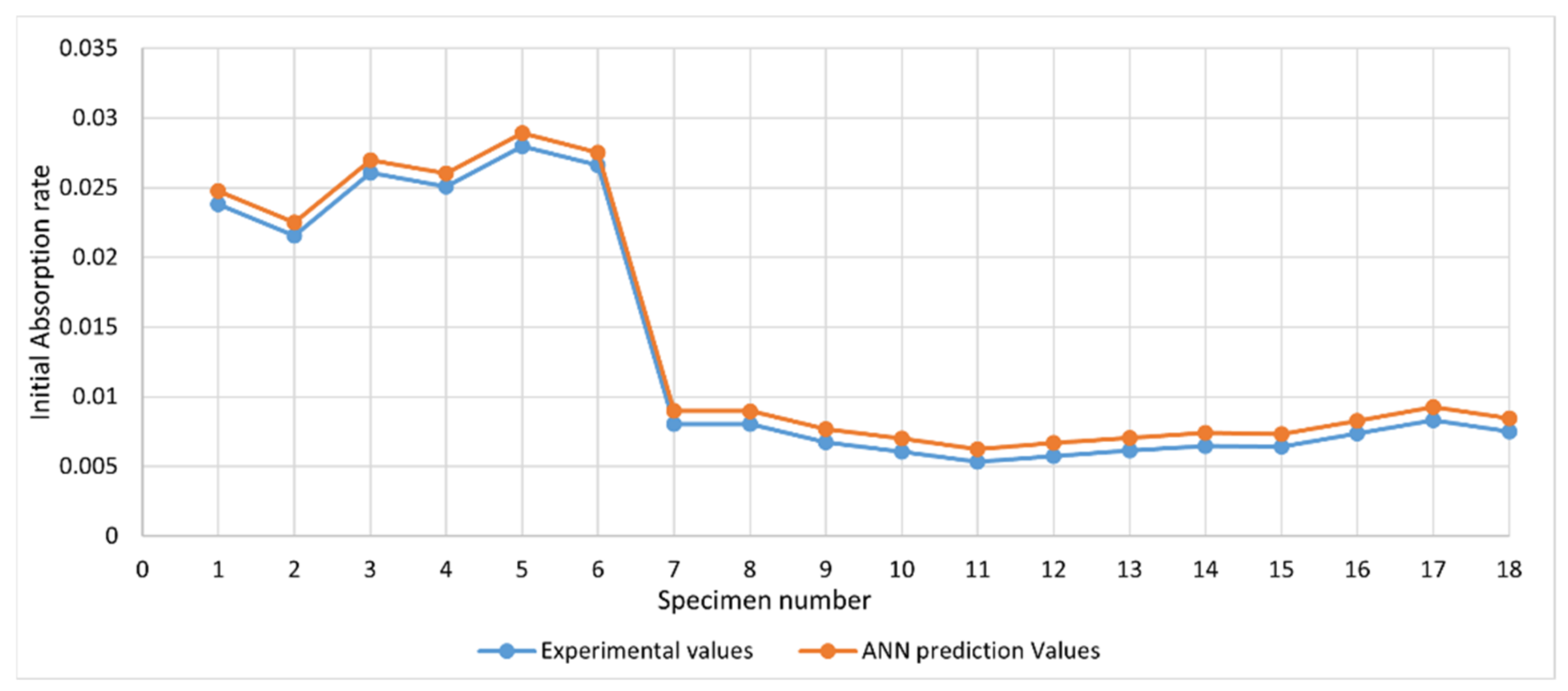
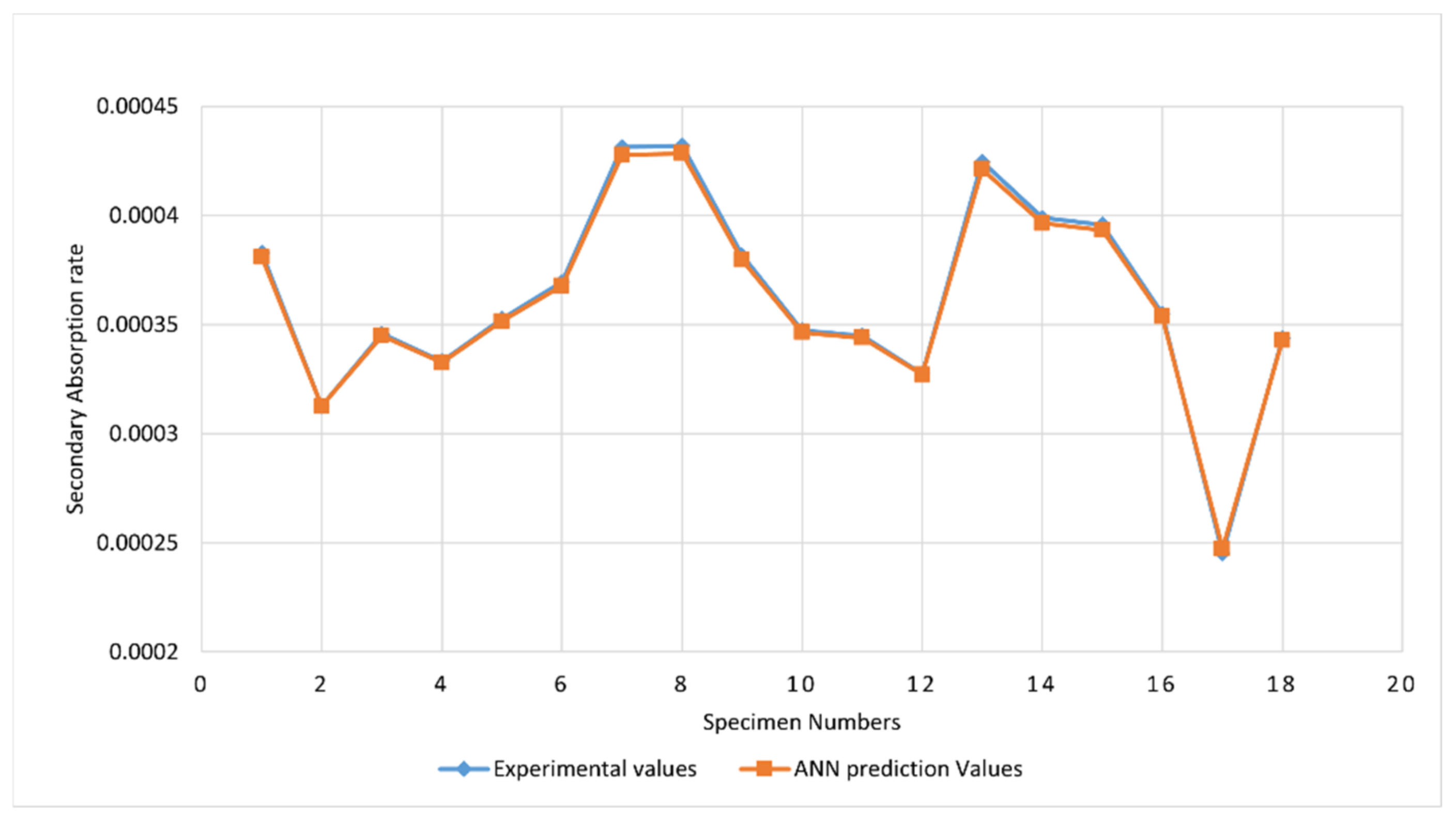
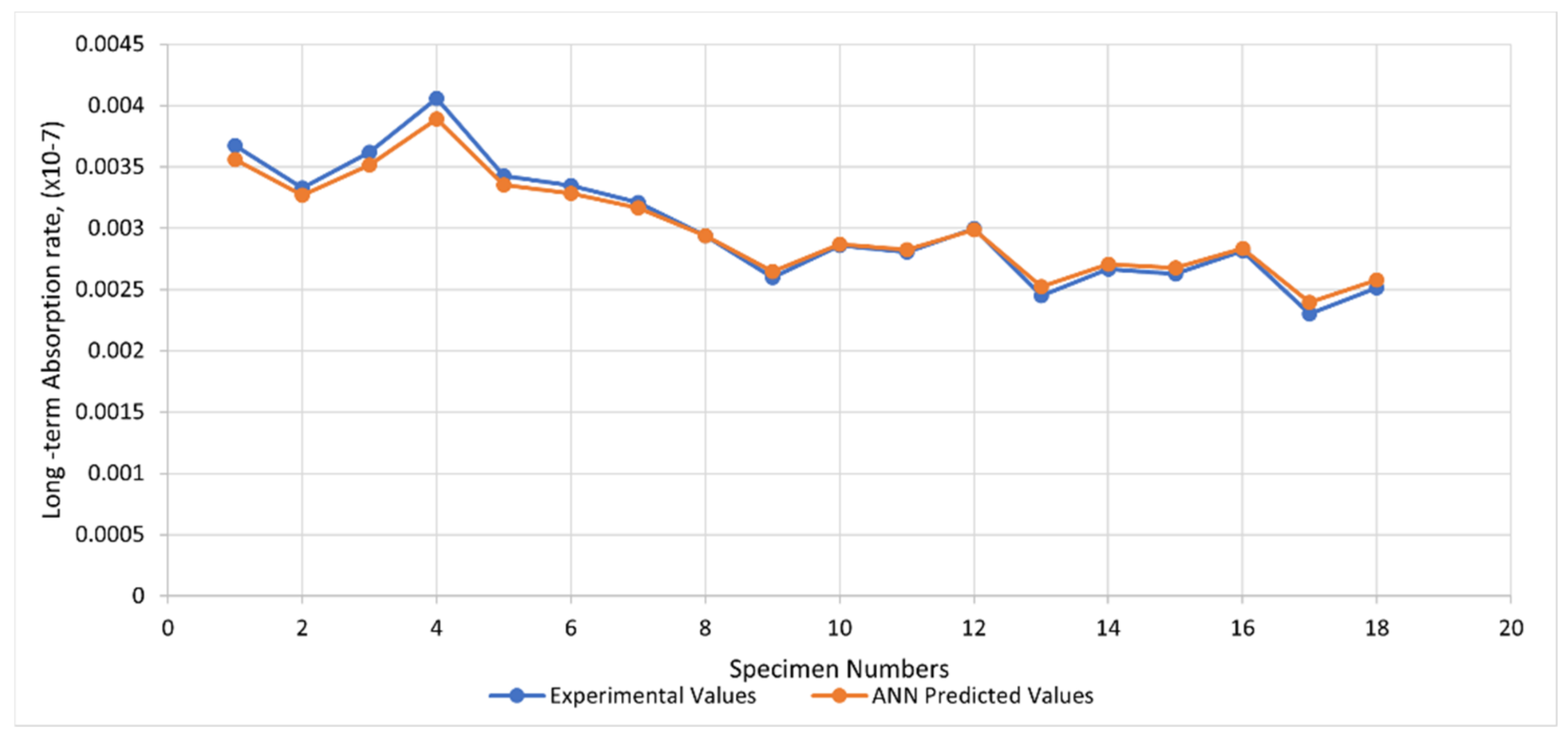
| Chemical Composition | SiO2 | CaO | Al2O3 | MgO | K2O | SO3 | V2O5 | TiO2 | Na2O | P2O5 | FeO |
|---|---|---|---|---|---|---|---|---|---|---|---|
| Fly Ash (%) | 65.75 | - | 32.87 | - | - | - | - | 1.38 | - | - | - |
| Slag (%) | 35.19 | 41.47 | 13.66 | 6.32 | - | 2.43 | 0.20 | 0.73 | - | - | - |
| Micro Fly Ash (%) | 63.09 | - | 32.26 | - | 0.83 | - | - | 1.67 | 0.41 | 0.62 | 1.12 |
| Mix | SCGC | SCGC-B-12 | SCGC-B-30 |
|---|---|---|---|
| Fly Ash (kg/m3) | 480 | 480 | 480 |
| Slag (kg/m3) | 360 | 360 | 360 |
| Micro Fly Ash (kg/m3) | 120 | 120 | 120 |
| Anhydrous Sodium metasilicate (kg/m3) | 96 | 96 | 96 |
| Fine Aggregate (kg/m3) | 763 | 763 | 763 |
| Coarse Aggregate (kg/m3) | 677 | 677 | 677 |
| Water (kg/m3) | 475 | 475 | 475 |
| 12 mm Chopped Basalt Fibre (%) | - | 1 | |
| 30 mm Chopped Basalt Fibre (%) | - | 1 |
| Mix | SCGC | SCGC-B-12 | SCGC-B-30 |
|---|---|---|---|
| Workability Properties | |||
| Slump Flow (mm) | 680 | 670 | 665 |
| T500 (s) | 3.9 | 4.1 | 4.5 |
| Mechanical Properties | |||
| Mass of Specimens at 28th day (kg) | 3.54 | 3.55 | 3.57 |
| Density of the Specimens at 28th day (kg/m3) | 2253.63 | 2260.00 | 2272.73 |
| Compressive Strength, at 28th day (MPa) | 42.02 | 39.89 | 40.12 |
| Indirect Tensile Strength, at 28th day (MPa) | 3.03 | 2.78 | 2.82 |
Publisher’s Note: MDPI stays neutral with regard to jurisdictional claims in published maps and institutional affiliations. |
© 2022 by the authors. Licensee MDPI, Basel, Switzerland. This article is an open access article distributed under the terms and conditions of the Creative Commons Attribution (CC BY) license (https://creativecommons.org/licenses/by/4.0/).
Share and Cite
Rahman, S.K.; Al-Ameri, R. Experimental and Artificial Neural Network-Based Study on the Sorptivity Characteristics of Geopolymer Concrete with Recycled Cementitious Materials and Basalt Fibres. Recycling 2022, 7, 55. https://doi.org/10.3390/recycling7040055
Rahman SK, Al-Ameri R. Experimental and Artificial Neural Network-Based Study on the Sorptivity Characteristics of Geopolymer Concrete with Recycled Cementitious Materials and Basalt Fibres. Recycling. 2022; 7(4):55. https://doi.org/10.3390/recycling7040055
Chicago/Turabian StyleRahman, Sherin Khadeeja, and Riyadh Al-Ameri. 2022. "Experimental and Artificial Neural Network-Based Study on the Sorptivity Characteristics of Geopolymer Concrete with Recycled Cementitious Materials and Basalt Fibres" Recycling 7, no. 4: 55. https://doi.org/10.3390/recycling7040055
APA StyleRahman, S. K., & Al-Ameri, R. (2022). Experimental and Artificial Neural Network-Based Study on the Sorptivity Characteristics of Geopolymer Concrete with Recycled Cementitious Materials and Basalt Fibres. Recycling, 7(4), 55. https://doi.org/10.3390/recycling7040055







